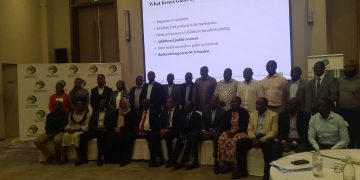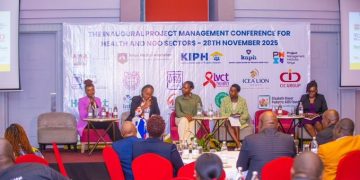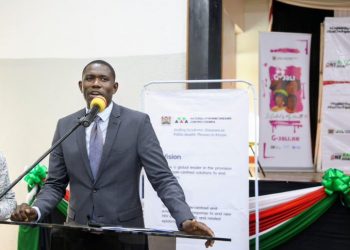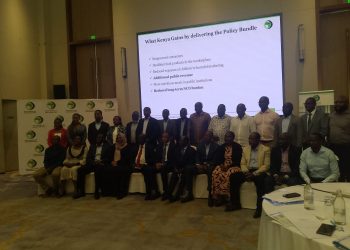By Pauline Achieng Tom @Pauline_tom
In Vihiga County, Wandanya sub-location- Mambai village the ministry of health (MOH) in lieu of community health workers conducted the distribution of long-lasting insecticidal nets (LLINS) to the members of the community in a bid to curb malaria.
However, According to Rose Asiri, a Community health worker at Mambai village, despite over 90 percent of households within the village have received free mosquito nets, many cases were still being reported to the dispensaries and hospitals.
“We noticed that malaria cases were still high even after the distribution of mosquito nets and after conducting a routine surveillance to monitor the use we realized they were improperly used,” she said.
“People were either not using the nets in fear of suffocating or using the nets for other things like fencing their gardens. This led to the need to have a community dialogue together with key members of the society including local authorities and religious leaders in order to initiate behavior change intervention.”
Small scale success
Currently, progress on malaria in the country has stalled, according to data from the Ministry of Health Division of Malaria programme (DNMP) malaria still accounts for well over 240 million cases and 627,000 deaths reported in 2021.The country still accounts for 1.3 per cent of global malaria deaths.
According to malaria epidemiologist, social behavior change communication when coupled with innovations in prevention, therapeutics and surveillance will lead to having a malaria free Kenya.
Human behavior modification is a tool that has been shown to work and could probably be efficient in Kenya.
This strategy has been introduced on a small scale in Malindi, Vihiga and Uriri by the Kenya Medical Research Institute (KEMRI) research teams in league with the ministry of health. It, has so far proven to be successful in control of malaria.
While in Malindi, a total of 11 community groups voluntarily participated in vector management activities, in Vihiga 207 groups of adults participated reaching about 2691 people.
Upon realizing the gaps in mosquito nets usage and overall lack of vector control awareness, ministry of health in Vihiga county with the help of Community health workers and volunteers embarked on community mobilization by making announcements about upcoming learning group sessions in churches, mosques, village meetings and women groups, with the help of community leaders and authority figures that helped them achieve acceptance within the community.
According Mercy Lodendwa,Ministry of health Vihiga county, once the sessions started people were divided into groups of 13 to 15 people and in the span of six months 207 groups were formed (712 men and 1,979 women), the sessions were held at the local primary school and dispensary where community health workers were able to educate and hold helpful discussions with the people of Mambai community unit and form a rapport that came in handy in the next year during follow up visits.
According to Lodendwa, Ministry of Health Vihiga County there was a reduction in malaria cases by 24 per cent reported in the second quarter of 2022 six months after community dialogue sessions began.
“We conducted community dialogue sessions in Vihiga and within the months of April to September we had completed 13 sessions in the villages of Mambai,” she stated.
“During our subsequent follow-ups within the year, results showed a reduction in the misuse of LLINS where only 13 households out of 1551 were found using the nets for fencing and proper net use was shown to be at 98 per cent.”
Mr. Collins Kafuna a resident of Mambai village who was involved in the community dialogue sessions in Vihiga said, “I have a better understanding of why we had such high incidences of malaria in our village, before our group sessions I also believed there was no reason to sleep under the nets during the day, but after various sessions I got to learn about the importance of mosquito nets.”
“We were also advised on the importance of seeking prompt medical care, especially for pregnant mothers, the proper use of mosquito nets and taking care of the bushes and stagnant water around our homes which are a breeding ground for mosquitoes.”
According Asiri, motivating the community to understand more about the mosquito and control measures and voluntarily taking part in vector management has made it easy to disseminate and communicate with the household owners on mosquito breeding areas and measures needed to control the larval habitats identified.
“During our sessions we talked to the community on mosquito breeding habits and the importance of draining stagnant waters, slashing overgrown grass and overall general cleanliness, we also explained the need to stay in the house during the nights and closing the windows and doors early to reduce mosquitoes in the house,” she adds.
During the follow-up visits, several issues were raised with participants citing them as a hindrance when implementing their newly acquired knowledge. According to Asiri, lack of consistent supply of LLIN by the government led to overuse that in turn undid the progress made by the participants.
“In some of the homes we visited, we realized that some of the mosquito nets had experience tear from use and due to financial constraints, the people just decided to sew them up which reduced the efficacy of the mosquito net.”
Speaking at the Fourth National malaria forum Dr. Eric Ochomo, Senior research officer at Kenya Medical Research Institute (KEMRI) Centre for global health research, stressed on the importance of Community involvement in Malaria control stating that communicating research findings to the community can help reduce incidences of malaria.
“It is important for people in endemic areas to understand the times where most mosquito bites take place, in average 350 mosquitoes enter a household in a single night in some villages and with slight human behavior intervention this can be prevented since 90 per cent of mosquito bites happen in the house,” Dr.Ochomo said.
Community understanding of major risk factor associated with malaria incidences is key to complementing existing malaria interventions and eradicating the disease. Human intervention through strategic social behavior changes and communication of the basic knowledge on malaria vectors can play a major role in eradication, he added.
In places like Vihiga community dialogue, led to increased uptake in seeking of medical assistance and in the span of six months the Mambai community unit generated 266 referrals including 38 pregnant women and 63 children under the age of five.
National implementation of community health dialogue could help significantly reduce the burden of malaria in the country.
Case studies presented at the forum showed that community dialogues in Vihiga, Uriri, and Malindi were successful.
A study conducted at Uriri showed that strengthening community case management of malaria intervention can improve coverage to routine prevention and curative services.
According to the studies, strengthening of routine community case management of malaria enhances both access and coverage for both preventive and curative malaria interventions.
The cost of carrying out community dialogue sessions in Kenya can be a significant challenge, especially in the rural areas due to limited Infrastructure and resources. The project heavily relied on community health workers and volunteers like Asiri.
Community dialogue sessions also require active participation from community members, which may mean taking time off from work or other daily activities.
“It is hard to convince people to take time off their income earning activities to come learn about malaria especially when they are already struggling to make ends meet,” Asiri noted.
Kenya also faces several challenges with poor malaria diagnostic and surveillance of malaria, emerging drug resistance and emergence of a further invasive mosquito (anopheles stephensi).
According to Dr. Ochoma there is need for strengthening malaria surveillance and diagnostics.
“More than ever, it is important that we stay vigilant and aggressive in our global eradication campaign of malaria which is an achievable fete, the fight to mitigation and eventual eradication of malaria comes with a lot of challenges including diagnostics which also plays a major role in malaria control there are concerns on the failure of rapid diagnostics tests (RDT),as well as the emergence of artemisinin resistance in Uganda, Eritrea and Rwanda,” he said.












